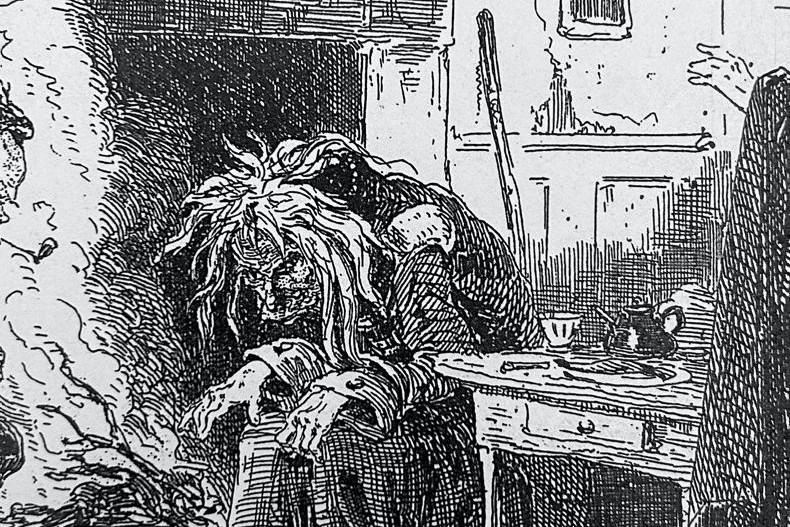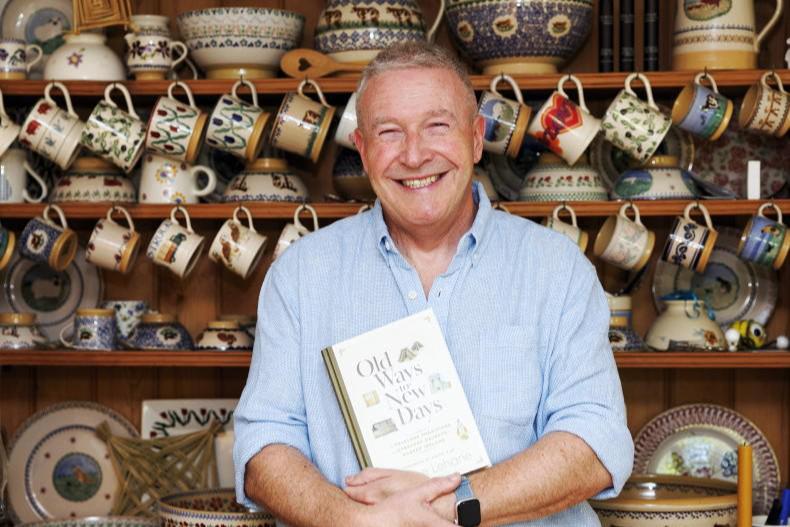Whether it was Darragh or Éowyn, the last few months of raging storms with hurricane-force winds, have toppled countless large trees all over the country. Sadly, for the most noble and elderly specimens, the older and larger the tree the greater the likelihood of their natural demise, being pushed over by the wind and uprooted.
A short distance from my own home, there is an old farm, perched on high ground above the Shournagh river, near Blarney. Hidden away from the main road, its winding boreen approaches an old house before it opens up to a long avenue that is sentinelled with a parade of tall coniferous trees.
This laneway has been bisected by the enormous trunk of a huge tree which came down in the storm. Its dark brown bark, undulating, ruffled and hairy is like the skin of a wrinkly old mammoth, but it is its sheer girth and size that has me mesmerised. This ubiquitous tree is most often referred to as ‘market carpet’, an affectionate Irish contraction of its Latin nomenclature Macrocarpa.
This is one of a number of pine trees that are native to one small corner of the west coast of California, the Monterey Peninsula. This little butt of land was a climatic refuge during the last ice age and the pines clung on and managed to survive, mostly as small bushes. They have since come to feature prominently throughout the Irish countryside.
Tree collectors
In 1793, the Scottish botanist and plant collector, Archibald Menzies, was on board HMS Discovery collecting specimens of trees and plants to return them to Britain and Ireland.
Menzies was one of the pioneers who brought the first seeds, cuttings and entire specimens of exotic botanical wonders that initially adorned the gardens of the great estates, before filtering out into the farms and gardens of today.
He kept the living specimens alive in cold frames on the fore deck of the ship as he transversed the Atlantic back to England. He and the other tree hunters and seed collectors that followed, are responsible for the introduction of the great sequoia redwoods, Sitka spruces, monkey puzzles, Douglas firs and other gigantic trees that grow so well in Ireland’s climate.
It is possible that it was Menzies who first brought the seed of the Monterey Cypress (Cupressus macrocarpa) and the Monterey Pine (Pinus radiata) back to Britain and Ireland when the fascination with the new pine trees was at its height.
The story of this tree continues with one Alymer Bourke Lambert, whose mother Bridget Bourke was the last of the Viscounts of the Castleburke Estate in Mayo.

Macrocarpa, Inniscarra, Co Cork.
Alymer, educated in Oxford, went on to become one of the elite pioneering botanists of his day, a member of the Linnaean Society and an avid collector and the chief categoriser of pine trees. He amassed the herbaria and seed collections of different collectors, including Menzies.
In 1838, he produced an envelope of some unprovenanced seeds to the Royal Horticultural Gardens in Cheswick and from this the first fledgling Macrocarpa was grown. As the new tree grew, it was a thing of great wonder, and its origin had to be located.
This task fell to the German botanist, Karl Theodor Hartweg, who headed off on a seed-collecting expedition for the Royal Horticultural Society. He discovered the original stands of trees in Monterey, California in 1848.
In their natural native setting, the small spherical cones of Macrocarpa rely on fire to open up and disperse their seeds. Hartweg bagged the seed-laden cones and returned to Kew Gardens with a stock.
The Chelsea-based Veitch Nurseries were the ones responsible for the popularisation and spread of the Californian trees.
Between 1850 and 1855, their tree and seed catalogues advertised the new species resulting in Macrocarpa and others being planted wholesale.
Estates such as Adare, Emo Court, Woodstock, Powerscourt, along with churchyards and parklands planted singular specimens but their rapid growth and evergreen foliage identified them as ideal for hedging and windbreaks.
By the turn of the century the large coniferous trees, were no longer the preserve of the large estates and became ever-present all over the country. Avenues and farmyards are surrounded on all sides by stands of ‘market carpets’.
As I plunged my chainsaw into the great bark and yellow orange wood of the Macrocarpa, I thought of Menzies, Alymer Bourke Lambert and Karl Hartweg and the magical journey of the ‘market carpet’.
Shane Lehane is a folklorist and works in UCC and Cork College of FET, Tramore. Road Campus. Email: slehane@ucc.ie
Whether it was Darragh or Éowyn, the last few months of raging storms with hurricane-force winds, have toppled countless large trees all over the country. Sadly, for the most noble and elderly specimens, the older and larger the tree the greater the likelihood of their natural demise, being pushed over by the wind and uprooted.
A short distance from my own home, there is an old farm, perched on high ground above the Shournagh river, near Blarney. Hidden away from the main road, its winding boreen approaches an old house before it opens up to a long avenue that is sentinelled with a parade of tall coniferous trees.
This laneway has been bisected by the enormous trunk of a huge tree which came down in the storm. Its dark brown bark, undulating, ruffled and hairy is like the skin of a wrinkly old mammoth, but it is its sheer girth and size that has me mesmerised. This ubiquitous tree is most often referred to as ‘market carpet’, an affectionate Irish contraction of its Latin nomenclature Macrocarpa.
This is one of a number of pine trees that are native to one small corner of the west coast of California, the Monterey Peninsula. This little butt of land was a climatic refuge during the last ice age and the pines clung on and managed to survive, mostly as small bushes. They have since come to feature prominently throughout the Irish countryside.
Tree collectors
In 1793, the Scottish botanist and plant collector, Archibald Menzies, was on board HMS Discovery collecting specimens of trees and plants to return them to Britain and Ireland.
Menzies was one of the pioneers who brought the first seeds, cuttings and entire specimens of exotic botanical wonders that initially adorned the gardens of the great estates, before filtering out into the farms and gardens of today.
He kept the living specimens alive in cold frames on the fore deck of the ship as he transversed the Atlantic back to England. He and the other tree hunters and seed collectors that followed, are responsible for the introduction of the great sequoia redwoods, Sitka spruces, monkey puzzles, Douglas firs and other gigantic trees that grow so well in Ireland’s climate.
It is possible that it was Menzies who first brought the seed of the Monterey Cypress (Cupressus macrocarpa) and the Monterey Pine (Pinus radiata) back to Britain and Ireland when the fascination with the new pine trees was at its height.
The story of this tree continues with one Alymer Bourke Lambert, whose mother Bridget Bourke was the last of the Viscounts of the Castleburke Estate in Mayo.

Macrocarpa, Inniscarra, Co Cork.
Alymer, educated in Oxford, went on to become one of the elite pioneering botanists of his day, a member of the Linnaean Society and an avid collector and the chief categoriser of pine trees. He amassed the herbaria and seed collections of different collectors, including Menzies.
In 1838, he produced an envelope of some unprovenanced seeds to the Royal Horticultural Gardens in Cheswick and from this the first fledgling Macrocarpa was grown. As the new tree grew, it was a thing of great wonder, and its origin had to be located.
This task fell to the German botanist, Karl Theodor Hartweg, who headed off on a seed-collecting expedition for the Royal Horticultural Society. He discovered the original stands of trees in Monterey, California in 1848.
In their natural native setting, the small spherical cones of Macrocarpa rely on fire to open up and disperse their seeds. Hartweg bagged the seed-laden cones and returned to Kew Gardens with a stock.
The Chelsea-based Veitch Nurseries were the ones responsible for the popularisation and spread of the Californian trees.
Between 1850 and 1855, their tree and seed catalogues advertised the new species resulting in Macrocarpa and others being planted wholesale.
Estates such as Adare, Emo Court, Woodstock, Powerscourt, along with churchyards and parklands planted singular specimens but their rapid growth and evergreen foliage identified them as ideal for hedging and windbreaks.
By the turn of the century the large coniferous trees, were no longer the preserve of the large estates and became ever-present all over the country. Avenues and farmyards are surrounded on all sides by stands of ‘market carpets’.
As I plunged my chainsaw into the great bark and yellow orange wood of the Macrocarpa, I thought of Menzies, Alymer Bourke Lambert and Karl Hartweg and the magical journey of the ‘market carpet’.
Shane Lehane is a folklorist and works in UCC and Cork College of FET, Tramore. Road Campus. Email: slehane@ucc.ie










SHARING OPTIONS